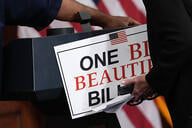You have /5 articles left.
Sign up for a free account or log in.
The U.S. Treasury Department on Friday released long-awaited guidance designed to clarify the impact of the so-called endowment tax that Congress approved as a part of a sweeping tax bill in late 2017.
The tax, a 1.4 percent excise tax on net investment income at private colleges and universities with at least 500 tuition-paying students and assets of at least $500,000 per student, has generated intense pushback.
College and university leaders -- especially those at the wealthy private nonprofit institutions that are subject to the excise tax -- generally oppose the new tax, but they have nonetheless been eager for information about its impact. The guidelines don't break a ton of new ground, but they define some terms in ways that will help colleges' lawyers, business officers and others gauge which institutions will be affected, and how.
Most experts said they were still reviewing the guidelines (which were part of a time-honored late Friday afternoon news dump that also included the Education Department's release of its final repeal of the gainful-employment rules for vocational programs) and could not offer much in the way of insights into the guidelines' potential impact.
“The implementation of this misguided excise tax will be extremely complex, and the legislation as enacted by Congress itself is vague and ambiguous in important respects," said Steven M. Bloom, director of government relations at the American Council on Education. "So the proposed regulations released late Friday afternoon are a long-awaited and necessary step to ensure that colleges and universities understand, first, whether they are even covered by the new excise tax and, if so, how they are obligated to comply with it. We will be carefully examining the proposed rules to ascertain how they will work in practice and whether they will do more harm than good, and will comment in more detail after we have completed our review.”
But some legal experts reached by Inside Higher Ed over the weekend said the guidance confirmed some expectations and confounded a few others.
First and foremost, the basic outlines of the guidance leave unchanged earlier expectations that about 25 to 30 large-endowment institutions would be affected by the endowment tax in the first year, said Daniel Romano, a partner at Grant Thornton who provides tax services for the nonprofit and higher education sectors.
Most of the new information in the guidance relates to questions such as how to calculate the number of students that institutions have and what counts as net investment income.
For instance, the guidance clarifies that the student count includes part-time students but is calculated using a full-time-equivalent enrollment. Students must have actually attended class, not just be enrolled.
The legislation counts as students those who are "tuition-paying," and the regulations clarify that a student who pays any portion of his or her tuition (or has that tuition covered by a third party) must be counted. That suggests, Romano said, that any student who receive a full scholarship directly from an institution would not count as a student. Small colleges that are near the 500-student mark (and want to stay under that mark) might rejigger their financial aid dollars to cover tuition rather than room and board, Romano said.
The guidance's definition of what counts as net investment income could also affect institutions' obligations under the law.
Many of the definitions in the regulations are drawn from similar federal rules that govern private foundations. Like those rules, the guidance clarifies that colleges can exclude from the calculation of their net investment income 1.5 percent of the total, to keep on hand as a cash balance. (As is true in other cases, the IRS seeks advice from college officials about whether the 1.5 percent figure that applies to private foundations is an appropriate figure in this situation, as well.)
Colleges and universities are also able to count as educational expenses that are exempt from taxation (as opposed to investment income that is subject to the endowment tax) buildings and other assets that are used directly for educational purposes.
The IRS proposes that a building can be considered exempt from the tax if 95 percent of its total use is for educational as opposed to nonexempt purposes. Romano said he expected that colleges might seek to lower that percentage, to exclude more mixed-use buildings from the calculation.
The guidance also notes that using the federal rules governing private foundations, student loan interest and rental income would be included as taxable investment income for colleges and universities under the endowment tax.
Romano said it would be odd not to consider rental income that colleges receive from students in residence halls as income related to their educational missions, given that for many students, "part of the educational experience is living on campus."





